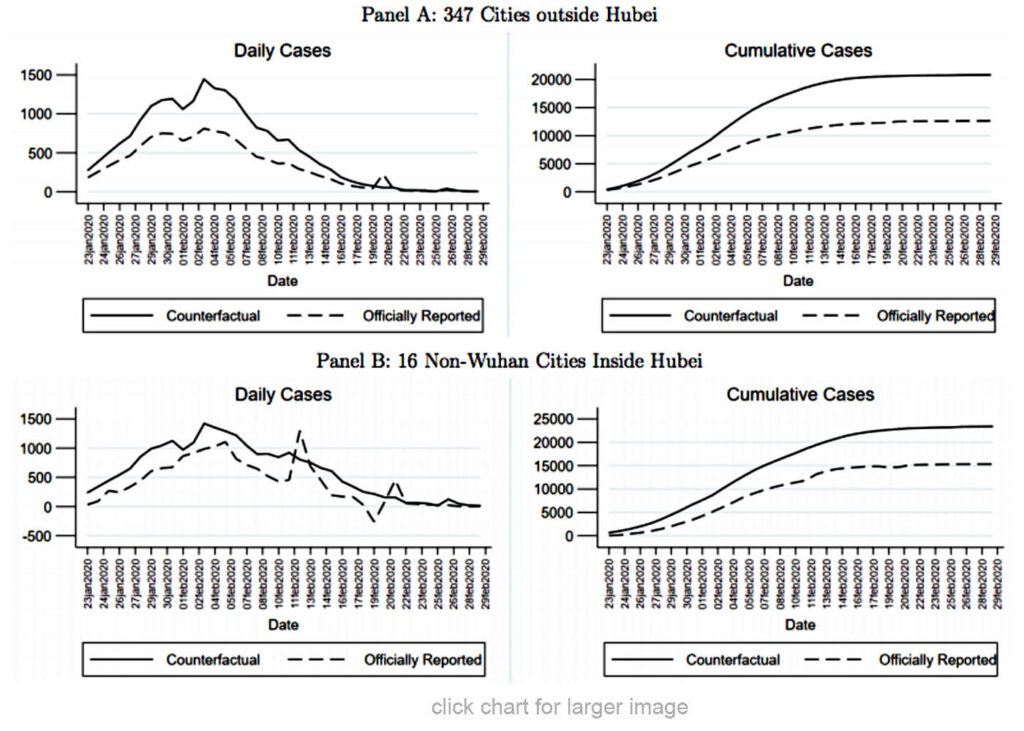Blog Post
Wuhan Lockdown Halted Spread of Coronavirus Across China
New Econometric Study Quantifies Impact Over Five Weeks
As increasing numbers of people domestically and abroad face mandatory “lockdowns,” we have new evidence that these severe restrictions on movement are effective in containing the spread of the novel coronavirus. In a just-released working paper, LDI Senior Fellow Hanming Fang, PhD and colleagues Long Wang, PhD, of ShanghaiTech University, and Yang (Zoe) Yang, PhD, of Chinese University of Hong Kong, quantify the effects of the lockdown of the city of Wuhan on January 23, 2020, showing that it played a crucial role in reducing cases of COVID-19 in other Chinese cities and halting the spread of the virus.
Without the Wuhan lockdown, the researchers estimate that between January 23, 2020 and February 29, 2020, COVID-19 cases would have been 65% higher in the 347 Chinese cities outside Hubei province, and 53% higher in the 16 non-Wuhan cities inside Hubei, even with the social distancing measures implemented by other cities. In their “counterfactual” simulations (that is, with no Wuhan lockdown), cities outside Hubei province would have had 20,810 cases, compared to the 12,626 they actually recorded; cities inside Hubei (other than Wuhan) would have had 23,400 cases, compared to 15,330 actual cases. This striking impact is shown, daily and cumulatively, in the Figure below:

These findings are consistent with other emerging research on Wuhan based on machine learning tools, mathematical modeling, and a population epidemic model, but this is the first to provide a causal interpretation of how a lockdown affects human mobility and the spread of the novel coronavirus. Using difference-in-differences (DID) estimations, Fang and colleagues could disentangle the lockdown effect on people’s movements from the effects of other factors, such as panic (when the Chinese government official confirmed person-to-person transmission on January 20, 2020, three days before lockdown), voluntary reductions in mobility in response to the epidemic, and the Spring Festival of the Chinese New Year (on January 25, 2020).
The researchers used real-time data from Baidu (China’s dominant search engine) to measure migration among pairs of Chinese cities and movement within each city at the daily level. Baidu Migration data is based on real-time location records for every smartphone using the company’s mapping app, providing a precise estimate of human mobility. The analysis spans the period from January 1-February 29, 2020, covering 22 days before and 38 days after the city lockdown on January 23, 2020, with matched data from the same lunar calendar period in 2019. The researchers combined these data with city-level daily counts of confirmed COVID-19 cases, recovered patients, and deaths tolls from the Chinese Center for Disease Control and Prevention.
The counterfactual model also allowed the researchers to project the timing of new infection cases in other cities if the lockdown of Wuhan, a city of 11 million people, had not occurred. For the other cities in the province, new daily infection cases would have peaked on February 2, nine days after the Wuhan lockdown, at a level of 1,466 daily new cases; and elsewhere in China, it would have peaked on February 3, ten days after the Wuhan lockdown, at a level of 1,082 daily new cases. They found that the estimated daily new cases in the counterfactual would gradually converge to the reported daily cases from February 22, suggesting that the social distancing measures implemented elsewhere in China would have worked eventually to contain the spread of the virus. But without the Wuhan lockdown on January 23, 2020, the initial onslaught of patients to the medical system in all cities in China would have been much more severe, and the total number of cases elsewhere would have been significantly higher.
Fang and his colleagues point out that although the study focuses only on the effects of lockdown restrictions in China, their findings have general implications for other countries in their fight against COVID-19. They state:
The results from our analysis provide valuable causal evidence on the role of human mobility restrictions on the containment and delay of the spread of contagious viruses, including the 2019-nCoV virus that is now ravaging the world. Social distancing, and, if an epicenter can be identified as was the case for the city of Wuhan in China, a lockdown, can play crucial roles in “flattening” the daily infection cases curve, giving the stressed medical system a chance to regroup and deal with the onslaught of new infection cases.
The Researcher
HANMING FANG, PhD

In an interview with LDI, Hanming Fang, a Penn Professor of both Economics at the School of Arts & Sciences and Health Care Management at Wharton, noted that “This Wuhan lockdown was quite unprecedented and, at first glance, it seems to be what you want to do to prevent the virus from spreading, but the cost of locking down that many people is huge.”
Panicked outflow
“The key thing it did was prevent a panicked outflow of people, some of them infected, to other cities,” Fang said. “That early isolation of Wuhan slowed the spread of the disease by providing other cities with more time to prepare for their own wave of infections and patient loads.”
He noted there is no precise lesson in these initial findings for the U.S. because the dynamics of the virus’ emergence were so different in each country.
“Wuhan was where the COVID-19 cases were first reported and was clearly China’s huge epicenter,” Fang said, “but in the U.S., there’s no clear epicenter like that. You have small clusters on both coasts and then community spread. It’s a much different situation.”
Tightly confined
Fang also pointed out that the term “lockdown” means different things in either country. In the Wuhan lockdown, people were not allowed to leave or enter the city at the same time residents were tightly confined to their homes.
“At first, each household would get maybe two passes that would allow them to go out to get groceries,” Fang explained. “But later, they weren’t even allowed to do that. Instead, community organizers delivered groceries to their doorsteps. The whole concept of ‘lockdown’ is much stricter in China than the U.S.”
Social distancing
“Clearly,” Fang said,” mobility restrictions are important in containing the spread of a virus like this, but a lot of people in the U.S. right now are asking exactly how effective is social distancing in reducing infection cases? We’re now doing additional work in an effort to tease out the causal impact of social distancing on virus spread in China and we hope to later add those findings to this draft working paper.”
~ Hoag Levins